Centauri Dreams
Imagining and Planning Interstellar Exploration
What Phosphine Means on Venus
A biosignature is always going to create a rolling discussion that gradually homes in on a consensus. Which is to say that the recent discovery of phosphine in the upper atmosphere of Venus has inspired a major effort to figure out how phosphine could emerge abiotically. After all, the scientists behind the just published paper on the phosphine discovery seem to be saying something to the community like “We can’t come up with a solution other than life to explain this. Maybe you can.”
The ‘maybes’ are out there and they include life, but what a tough spot for life to develop, for obvious reasons, not the least of which is the hyper-acidic nature of its clouds. So let’s dig into the story a bit more. The idea of life in the cloud layers of an atmosphere has a long pedigree, even on Venus, where discussions go back at least to the 1960s. Harold Morowitz and Carl Sagan examined the matter in a paper in Science in 1967, a speculation that led them to conclude “it is by no means difficult to imagine an indigenous biology in the clouds of Venus.”
And while the temperature at Venus’ surface can reach 480° Celsius, the temperatures between 48 and 60 kilometers above the surface are relatively benign, in the range of 1° to 90° C. A team led by Jane Greaves (Cardiff University) detected the spectral signature of phosphine through observations at 1 millimeter wavelength made with the James Clerk Maxwell Telescope (JCMT) in Hawaii, later confirmed with data from the Atacama Large Millimeter Array (ALMA) observatory in Chile. The resulting paper is lengthy and judiciously written, as witness:
If no known chemical process can explain PH3 within the upper atmosphere of Venus, then it must be produced by a process not previously considered plausible for Venusian conditions. This could be unknown photochemistry or geochemistry, or possibly life. Information is lacking—as an example, the photochemistry of Venusian cloud droplets is almost completely unknown. Hence a possible droplet-phase photochemical source for PH3 must be considered (even though PH3 is oxidized by sulfuric acid). Questions of why hypothetical organisms on Venus might make PH3 are also highly speculative…
And here again, the note that what we are talking about is unusual chemistry:
Even if confirmed, we emphasize that the detection of PH3 is not robust evidence for life, only for anomalous and unexplained chemistry. There are substantial conceptual problems for the idea of life in Venus’s clouds—the environment is extremely dehydrating as well as hyperacidic. However, we have ruled out many chemical routes to PH3…
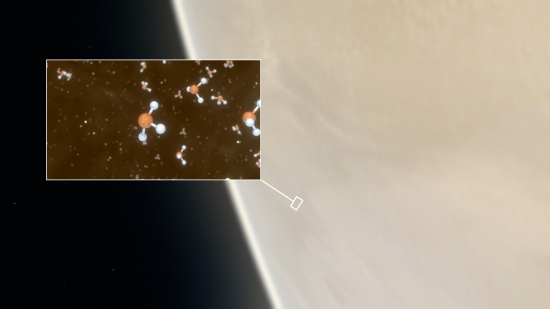
Image: Artist’s impression of Venus, with an inset showing a representation of the phosphine molecules detected in the high cloud decks. Credit: ESO / M. Kornmesser / L. Calçada & NASA / JPL / Caltech. Licence type Attribution (CC BY 4.0).
Phosphine is a rare molecule, one that is made on Earth through industrial methods, although microbes that live in environments without oxygen can likewise produce it when phosphate is drawn from minerals or other sources and coupled with hydrogen. MIT researchers have previously investigated it as a potential biosignature, one of a great many studied by Sara Seager and William Bains that we’ll want to use in our investigations of exoplanet atmospheres. It’s clear, though, that no one expected to find it in the clouds of Venus. Greaves explains:
“This was an experiment made out of pure curiosity, really – taking advantage of JCMT’s powerful technology, and thinking about future instruments. I thought we’d just be able to rule out extreme scenarios, like the clouds being stuffed full of organisms. When we got the first hints of phosphine in Venus’ spectrum, it was a shock!… In the end, we found that both observatories had seen the same thing – faint absorption at the right wavelength to be phosphine gas, where the molecules are backlit by the warmer clouds below.”
The international team working on the phosphine detection has investigated everything from minerals drawn into the clouds from the surface to volcanes, lightning, even sunlight, but none of the processes examined made enough phosphine to account for the data. In fact, the abiotic methods could produce at best one ten thousandth of the amount found in the telescope data.
But what a tough place for life to persist given an atmosphere where the high clouds are about 90 percent sulphuric acid. The hostility of the Venusian environment doubles down on the question of whether there are abiotic processes we have yet to consider. Following up on the phosphine detection, a new paper from the MIT researchers homes in on the matter:
(Greaves et al. 2020) have reported the candidate spectral signature of phosphine at altitudes >~57 km in the clouds of Venus, corresponding to an abundance of tens of ppb [parts per billion]. It was previously predicted that any detectable abundance of PH3 in the atmosphere of a rocky planet would be an indicator of biological activity (Sousa-Silva et al. 2020). In this paper we show in detail that no abiotic mechanism based on our current understanding of Venus can explain the presence of ~20 ppb phosphine in Venus’ clouds. If the detection is correct, then this means that our current understanding of Venus is significantly incomplete.
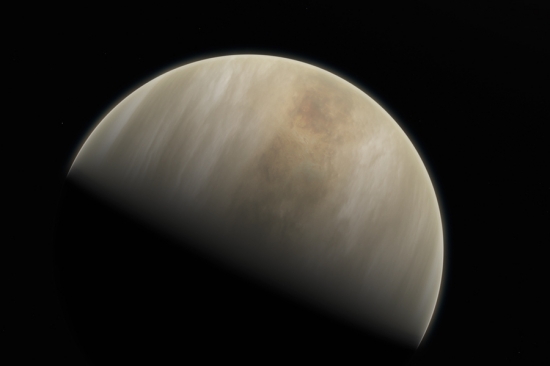
Image: This artistic impression depicts Venus. Astronomers at MIT, Cardiff University, and elsewhere may have observed signs of life in the atmosphere of Venus. Credit: ESO (European Space Organization)/M. Kornmesser & NASA/JPL/Caltech.
And from MIT co-author Clara Sousa-Silva, who examined phosphine as an exoplanet biosignature in a paper earlier this year, a look at the broader implications:
“A long time ago, Venus is thought to have oceans, and was probably habitable like Earth. As Venus became less hospitable, life would have had to adapt, and they could now be in this narrow envelope of the atmosphere where they can still survive. This could show that even a planet at the edge of the habitable zone could have an atmosphere with a local aerial habitable envelope.”
What a boon this finding will be to those interested in taking our eye off Mars for an astrobiological moment and looking toward the nearest terrestrial planet, for follow-up studies have to include one or more missions to Venus to study its atmosphere, perhaps including some kind of sampling and return to Earth. The MIT paper, Bains et al. as referenced below, includes both Seager and Sousa-Silva as co-authors, along with Cardiff’s Greaves, and bears a title that defines the issue: “Phosphine on Venus Cannot be Explained by Conventional Processes.”
Seager’s work on a wide range of potential biosignatures is definitive and has been examined before in these pages. Anyone interested in the broader question of how we go about defining a biosignature needs to get conversant with her “Toward a List of Molecules as Potential Biosignature Gases for the Search for Life on Exoplanets and Applications to Terrestrial Biochemistry,” Astrobiology, June 2016, 16(6): 465-485 (abstract).
So perhaps life, or perhaps a yet undiscovered mechanism for producing phosphine on Venus. Either way, the path forward includes an examination of a possible paradigm shift — the authors use this phrase — involving not just Venus but terrestrial planets in general. And I think we can assume that laboratory work on phosphorous chemistry is about to get a major boost.
The paper is Greaves et al., “Phosphine gas in the cloud decks of Venus,” Nature Astronomy 14 September 2020 (abstract). The MIT paper is Bains et al., “Phosphine on Venus Cannot be Explained by Conventional Processes,” submitted to Astrobiology – Special Collection: Venus (preprint). The Sousa-Silva paper on phosphine is “Phosphine as a Biosignature Gas in Exoplanet Atmospheres,” Astrobiology Vol. 20, No. 2 (31 January 2020). Abstract.

Exploring Tidal Heating in Large Moons
Io, Jupiter’s large, inner Galilean moon, is the very definition of a tortured surface, as seen in the image below, taken by the Galileo spacecraft in 1997. Discovering volcanic activity — and plenty of it — on Io was one of the early Voyager surprises, even if it didn’t surprise astrophysicist Stanton Peale (UC-Santa Barbara) and colleagues, who predicted the phenomenon in a paper published shortly before Voyager 1’s encounter. We now know that Io is home to over 400 active volcanoes, making it the most geologically active body in the Solar System.
We’re a long way from the Sun here, but we know to ascribe Io’s surface upheaval to tidal heating forced by the presence of Jupiter as the gravitational forces involved stretch and squeeze not just Io but, of course, Europa, Ganymede and Callisto, all of them interesting because of the possibility of liquid oceans beneath the surface. Io is close enough to the giant world that rock can be melted into magma, but it’s the ice under more distant Europa that gets the lion’s share of interest because of its astrobiological possibilities. And now we learn that not just Jupiter but the other Jovian moons may be involved in significant tidal heating effects.
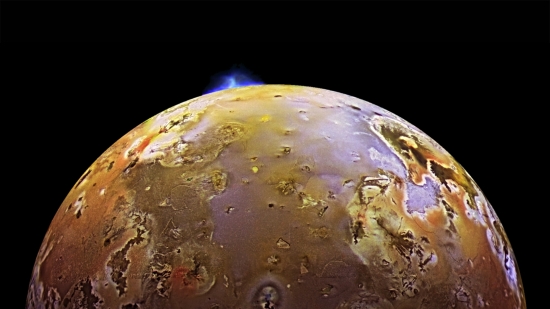
Image: NASA’s Galileo spacecraft caught Jupiter’s moon Io, the planet’s third-largest moon, undergoing a volcanic eruption. Locked in a perpetual tug of war between the imposing gravity of Jupiter and the smaller, consistent pulls of its neighboring moons, Io’s distorted orbit causes it to flex as it swoops around the gas giant. The stretching causes friction and intense heat in Io’s interior, sparking massive eruptions across its surface. Credit: NASA.
In the paper on this work, recently published in Geophysical Research Letters, lead author Hamish Hay (JPL) refines graduate work he performed at the University of Arizona’s Lunar and Planetary Laboratory. The scientists have found that the tidal response to other moons is surprisingly large, and consider it an important factor in the evolution of the satellite system at Jupiter, which comprises almost 80 moons in its entirety. Subsurface oceans could be maintained only through a balance between internal heat and its dissipation, so we need to know where this heat comes from and how it is distributed to understand these oceans.
Resonance appears to be the key. Push any object and let go and you create a wobble at the object’s own natural frequency. Hay uses the example of pushing a swing to explain it: Keep pushing the swing at that frequency and the resulting oscillations increase. Push at the wrong frequency — or in Hay’s analogy, push the swing at the wrong time — and the swing’s motion is dampened. In the case of the Jovian moons, the depth of a subsurface ocean determines the natural frequency of each of the moons the team studied. Says Hay:
“These tidal resonances were known before this work, but only known for tides due to Jupiter, which can only create this resonance effect if the ocean is really thin (less than 300 meters or under 1,000 feet), which is unlikely. When tidal forces act on a global ocean, it creates a tidal wave on the surface that ends up propagating around the equator with a certain frequency, or period.”

Image: The four largest moons of Jupiter in order of distance from Jupiter: Io, Europa, Ganymede and Callisto. Credit: NASA.
Hay and company are arguing that each Galilean moon raises tides on the others, even if we’ve ignored the process in the past because Jupiter’s gravitational effects are obviously so huge. The researchers have modeled subsurface tidal currents to study how the resonant response of an ocean shows up in the generation of tidal waves that can release significant amounts of heat into the oceans and crusts of Io (where the ocean is thought to be magma) and Europa.
The result: Jupiter alone, in this modeling, cannot account for tides of the right frequency to cause the necessary resonance to maintain the internal oceans we believe exist among these moons, because the oceans we predict under the ice on moons like Europa are simply too deep. The gravitational effects of other moons have to be added to those of Jupiter to produce the requisite tidal forces. The resulting tidal resonance produced by Jupiter and the other moons produces oceans stable over geological time that must be tens to hundreds of kilometers deep.
If this is correct, there should be observable effects on the surface, opening the way for new observations as future spacecraft explore the Galilean moons. From the paper:
Additional observable signatures may emerge if an ocean is nearly resonant. The dominant modes due to moon forcing are westward?propagating tidal waves. These waves produce unique, zonally symmetric patterns of time?averaged heat flux, with heating focused toward low latitudes and peaking either side of the equator (Figure 3b). Heightened geological activity at low latitudes would be expected from such a distribution of heat flow, which has been suggested from the locations of chaos terrains on Europa (Figueredo & Greeley, 2004; Soderlund et al., 2014) and volcanism on Io (Mura et al., 2020; Veeder et al., 2012), although the polar coverage is poor. The crust would correspondingly be thinner at low latitudes, which could be observable using gravity and topography data. Small?scale turbulent mixing in the ocean may act to diffuse this heating pattern…
The heating pattern explored in this paper is, the scientists say, significantly different from the tidal heating forced by Jupiter in the crust, which tends to be enhanced toward the poles. The authors see consequences for the ambient magnetic field that the paper explores, and which would be within the sensitivity of the magnetometer to be flown aboard the upcoming JUICE mission, and probably within range of the instrumentation on Europa Clipper.
There are interesting exoplanet implications here as well. Note this:
Our study suggests for the first time a mechanism where the ocean could play a crucial role in the heat budget of the Galilean moons, as opposed to previous studies limited to diurnal frequencies where dissipation is often negligible (e.g., Chen et al., 2014; Hay & Matsuyama, 2019a). In light of this, reexamination of evolution models may be needed in the future. The effect of moon?moon tides may be even larger in the TRAPPIST?1 system if any of the planets contain significant bodies of liquid, as has been suggested (Grimm et al., 2018). The habitability of closely packed ocean worlds may depend on these tides.
The paper is Hay et al., “Powering the Galilean Satellites with Moon?Moon Tides,” Geophysical Research Letters Vol. 47, Issue 15 (16 August 2020). Abstract/ Full Text.

Janus: Twin Spacecraft to Study Binary Asteroids
When we looked earlier this week at the Solaris mission, a concept designed to study the Sun’s polar regions, I commented on another early concept called the Auroral Reconstruction CubeSwarm (ARCS). The mission intrigued me because it consisted of CubeSats in swarm formation, working together with numerous ground observatories, to study the Earth’s auroras. The paradigm of miniaturization, low cost and creative design surfaces yet again in Janus, a proposal out of the University of Colorado at Boulder and Lockheed Martin that would involve twin spacecraft studying twin targets, the binary asteroids 1996 FG3 and 1991 VH.
Daniel Scheeres (CU-Boulder) is principal investigator for Janus, the plan being for the university to handle the analysis of data and images from the mission, with Lockheed Martin building and operating the two spacecraft. It should be a familiar role for both entities, as Lockheed Martin supports operations for OSIRIS-REx at asteroid Bennu, while Scheeres leads the radio science team for that mission. Each Janus spacecraft is roughly the size of a suitcase, a carry-on at that, echoing the theme of keeping spacecraft small and straightforward.
Lockheed Martin’s Josh Wood is project manager for Janus:
“We see an advantage to be able to shrink our spacecraft. With technology advancements, we can now explore our solar system and address important science questions with smaller spacecraft… We see this evolution to smaller and more capable spacecraft being a key market in the future for scientific missions. Now, we want to execute and show that we can do it.”
Lowering costs and preparation time by using off-the-shelf components is all part of the same parameter space that supports the movement toward CubeSats and so-called SmallSats. The mission will be part of NASA’s SIMPLEx program, which focuses on small spacecraft and satellites, and is projected to cost less than $55 million.
The twin Janus spacecraft have a long journey ahead, with a gravity assist at Earth following an initial solar orbit and a subsequent trajectory that takes them beyond the orbit of Mars. The craft are to use VACCO MiPS (Micro-Propulsion System), a low-cost, cold gas propulsion option designed for CubeSats consisting of five thrusters for pitch, yaw, roll and delta-v.
Malin Space Science Systems is to provide the instrument suite including visible and infrared cameras, with power delivered by three deployable solar arrays and batteries. Launch is to be in 2022, with the twin craft lofted as secondary payloads on a Falcon-Heavy (Block 5) in the same launch that will carry the Psyche and EscaPADE missions.
From a short summary presented at the 51st Lunar and Planetary Science Conference (2020):
Janus science will combine flyby observations of the target binary asteroids with ground-based observations, enabling the high resolution imaging and thermal data to be placed into a global context and leveraging all available data to construct an accurate topographical and morphological model of these bodies. Based on these measurements, the formation and evolutionary implications for small rubble pile asteroids will be studied.
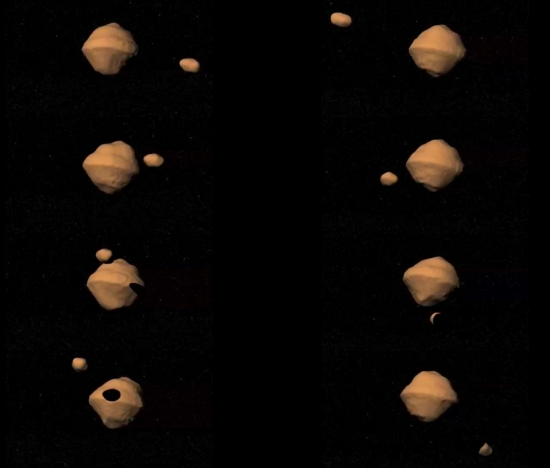
Image: Rendering of the orbital pattern of the binary asteroid 1999 KW4. We have much to learn about binary asteroids. (Credit: NASA/JPL).
Binary asteroids have yet to be studied up close, but this is a configuration that represents about 15 percent of the asteroids in the Solar System. Says Scheeres:
“We think that binary asteroids form when you have a single asteroid that gets spun up so fast that the whole thing splits in two and goes through this crazy dance… Once we see them up close, there will be a lot of questions we can answer, but these will raise new questions as well. We think Janus will motivate additional missions to binary asteroids.”

OSIRIS-REx: Tracking Bennu’s Unusual Activity
OSIRIS-REx, the little spacecraft with the big acronym (standing for Origins, Spectral Interpretation, Resource Identification, and Security-Regolith Explorer) has been on station for a year and a half at asteroid Bennu, monitoring the unexpected activity that distinguishes the object. Particle ejection from the surface is the subject of a revised special issue of the Journal of Geophysical Research: Planets collecting 10 papers on the matter.
Specifically, the spacecraft has found that particles of rock mostly of pebble-size are being ejected repeatedly — one or two per day — from the asteroid’s surface, some of them escaping into space, some moving into a temporary orbit, with the rest falling back onto the surface. Just days after entering orbit on December 31 of 2018, OSIRIS-REx began to spot the activity, which the introduction to the special issue refers to as “ongoing mass shedding” involving millimeter- to centimeter-scale particles. What we have on our hands here is an asteroid that is active.
Dante Lauretta (University of Arizona) is OSIRIS-REx principal investigator:
“We thought that Bennu’s boulder-covered surface was the wild card discovery at the asteroid, but these particle events definitely surprised us. We’ve spent the last year investigating Bennu’s active surface, and it’s provided us with a remarkable opportunity to expand our knowledge of how active asteroids behave.”
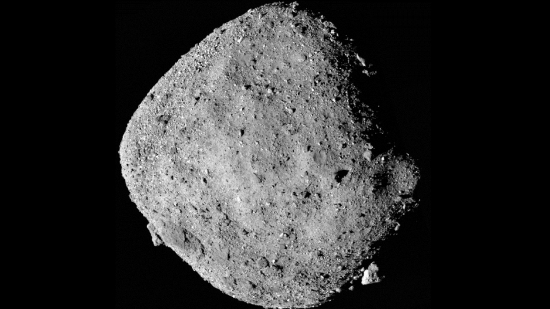
Image: This mosaic image of asteroid Bennu is composed of 12 images collected on Dec. 2, 2018, by the OSIRIS-REx spacecraft’s PolyCam instrument from a range of 24 kilometers. Credit: NASA/Goddard/University of Arizona.
Bennu is another example of the blurring of the distinction between comets and asteroids, the former composed of ice, rock and dust and subject to heating by the Sun during the approach to perihelion that causes the formation of the familiar tail as vapor and dust is carried into space. The rock and dust characteristic of asteroids wouldn’t seem to lend itself to such activity, but the papers here point to thermal fracturing that is the result of repeated heating and cooling as the object rotates as the likely driver. Also implicated: Impacts from meteoroids hitting the surface. From a paper on thermal fatigue by Jamie Molaro (Planetary Science Institute) and colleagues:
If thermal fatigue indeed plays a role in Bennu’s activity, this has broad implications for our understanding of active asteroids and the asteroid population as a whole. Previous works have hypothesized that thermal fracture processes may generate activity on active asteroids with small perihelion distances, such as (3200) Phaethon (Jewitt & Li, 2010). Our results support this hypothesis. With a diurnal temperature variation of hundreds of degrees, Phaethon’s surface is likely to be subject to thermal shock processes, with fatigue operating at depth to weaken and prepare the rock for disruption. However, the fact that thermal fatigue alone may be capable of generating activity suggests that there may be many more active asteroids than are currently known, likely including many in near?Earth space. With less energetic activity, a lack of tails or comae would make such bodies hard to identify from ground?based observations, and previous missions to visit asteroids up close lacked the capability to detect ejection events like those observed on Bennu.

Image: Occurrence of particle ejection events (circles) in the orbit of Bennu (orange). Ejection events of 2 to 19 particles are denoted by small gray circles; events of 20 or more particles are denoted by large black circles. The phases of the OSIRIS?REx mission that included dedicated particle monitoring (Orbitals A–C) are indicated with blue hatches. The Sun (yellow) and the orbits of Mercury (green), Venus (light blue), Earth (dark blue), and Mars (red) are also shown for reference. Credit: Hergenrother et al. (2020).
Mission scientists have been able to use the unexpected stream of particles as a probe of the asteroid’s gravitational field, for many of them were found to be orbiting much closer than the spacecraft itself, their trajectories sensitive to the irregular gravity of the object. The precision of the measurement is actually higher than would have been possible solely through the instruments aboard OSIRIS-REx. Chesley calls them “an unexpected gift for gravity science at Bennu since they allowed us to see tiny variations in the asteroid’s gravity field that we would not have known about otherwise.”
Remember that this is a sample return mission, with a touchdown planned for October 20 to gather surface material, some of which may contain particles that were ejected and have fallen back to the surface. We can look forward to the spacecraft’s return in September of 2023.
The papers on Bennu are gathered in “Exploration of the Activity of Asteroid (101955) Bennu,” a special edition of the Journal of Geophysical Research: Planets first published in April of 2020 and now updated as of 19 August. The paper quoted above is Molaro et al., “Thermal Fatigue as a Driving Mechanism for Activity on Asteroid Bennu,” JGR Planets 21 July 2020 (abstract).

A SETI Search of 10 Million Star Systems
As it is considered a precursor installation, the Murchison Widefield Array (MWA) in Western Australia doesn’t get the press that its proposed successor, the Square Kilometer Array (SKA) regularly receives. That’s to be expected, given the scope of the SKA, which will involve telescopes in both Australia and South Africa. 14 member countries are developing a project that is to reach over a square kilometer of collecting area, containing thousands of dishes and up to a million low-frequency antennas. If it is built, SKA’s angular resolution and survey speed will allow surveys thousands of times faster than those now being conducted.
But the Murchison precursor is alive and well, working the 70-300 MHz range and mapping the radio sky. Established by a consortium of universities — MIT, Swinburne, Curtin and Australian National University — the telescope is located on a site selected by these universities and managed by Curtin University. CSIRO, Australia’s national science agency, would later take over management of the site, which also now houses their SKA precursor instrument, ASKAP.
The MWA may be 50 times less sensitive than the SKA, but it has been put to work in areas ranging from the heliosphere to neutral hydrogen emission from the early universe. Its remit also includes several SETI studies, the latest being a search in the area of the constellation Vela (originally part of the larger Argo Navis constellation). The International Centre for Radio Astronomy Research calls this latest survey “the deepest and broadest search at low frequencies for alien technologies.” The results are now in the books, as reported in Publications of the Astronomical Society of Australia.
CSIRO astronomers Chenoa Tremblay and Steven Tingay (Curtin University) used the telescope’s wide field of view to observe millions of stars simultaneously. No technosignatures were detected, leading Tingay to observe:
“As Douglas Adams noted in The Hitchhikers Guide to the Galaxy, ‘space is big, really big’. And even though this was a really big study, the amount of space we looked at was the equivalent of trying to find something in the Earth’s oceans but only searching a volume of water equivalent to a large backyard swimming pool. Since we can’t really assume how possible alien civilisations might utilise technology, we need to search in many different ways. Using radio telescopes, we can explore an eight-dimensional search space. Although there is a long way to go in the search for extraterrestrial intelligence, telescopes such as the MWA will continue to push the limits—we have to keep looking.”
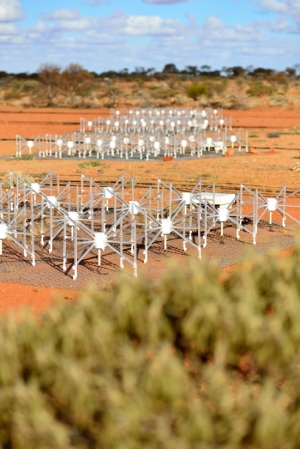
The scientists observed the sky in Vela for 17 hours, and point to the capabilities of the coming SKA, which if completed could be available late in this decade. SKA would extend the SETI search into billions of star systems, and would be capable of detecting what Tingay calls “Earth-like radio signals” from relatively nearby planetary systems, meaning, I assume, leakage radiation as opposed to directed signals designed to be interstellar. The current work follows earlier MWA surveys, one toward galactic center, the other in the anti-center direction.
From the paper:
Overall, our MWA surveys show the rapid progress that can currently be made in SETI at radio frequencies, using wide field and sensitive facilities, but also show that SETI surveys have a long way to go. The continued use of the MWA, and the future similar use of the SKA at much higher sensitivities, offers a mechanism to make significant cuts into the haystack fraction of Wright et al. (2018), while maintaining a primary focus on astrophysical investigations, making excellent commensal use of these large-scale facilities.
Image: Dipole antennas of the Murchison Widefield Array (MWA) radio telescope in Western Australia. Credit: Dragonfly Media.
On the matter of ‘haystack fractions,’ the phrase comes from a 2018 paper from Jason Wright (Penn State) and co-authors (two students in a graduate SETI course taught by Wright), which attempts to calculate the total fraction of the ‘haystack’ that has been searched to date, producing a result not far off what Jill Tarter calculated back in 2010: “…our current search completeness is extremely low, akin to having searched something like a large hot tub or small swimming pool’s worth of water out of all of Earth’s oceans.” Tarter’s comparison was to a drinking glass’s worth of seawater, so we’re in the same range.
Although I cited it in an earlier article (see Into the Cosmic Haystack) this quotation from the Wright et al. paper bears repeating:
We should be careful, however, not to let this result swing the pendulum of public perceptions of SETI too far the other way by suggesting that the SETI haystack is so large that we can never hope to find a needle. The whole haystack need only be searched if one needs to prove that there are zero needles—because technological life might spread through the Galaxy and/or technological species might arise independently in many places, we might expect there to be a great number of needles to be found. Also, our haystack definition included vast swaths of interstellar space where we have no particular reason to expect to find transmitters; humanity’s completeness to subsets of this haystack—for instance, for continuous, permanent transmissions from nearby stars—is many orders of magnitude higher.
Noting that “the dream of ‘all-sky, all the time” high bandwidth coverage is still worth pursuing, and singling out the Tingay et al surveys at the MWA in particular, Wright and colleagues say that surveys with large bandwidth, long exposures, repeat visits and good sensitivity allow for searches that are orders of magnitude faster than surveys without these qualities. Indeed, the three MWA low frequency surveys, because of their very wide field and sensitivity, dominate the haystack search volume, and as Wright notes, they did this in only a few hours of searching. The paper also notes how rapidly Breakthrough Listen is cutting into this search space, and that was before the most recent Breakthrough results were announced (see SETI: Going Deep with the Data Search).

Image: A 20-second exposure showing the Milky Way overhead the AAVS station. Credit: Michael Goh and ICRAR/Curtin.
The paper is Tremblay and Tingay, “A SETI Survey of the Vela Region using the Murchison Widefield Array: Orders of Magnitude Expansion in Search Space”, Publications of the Astronomical Society of Australia September 8th, 2020 (abstract). The Wright paper is “How Much SETI Has Been Done? Finding Needles in the n-Dimensional Cosmic Haystack,” Astronomical Journal Vol. 156, No. 6 (14 November 2018). Abstract / Preprint.

Solaris: To the Sun’s High Latitudes
I can think of more than one way to get a good look at the Sun’s polar regions. After all, we’ve done it before, through the Ulysses spacecraft, which passed over the Sun’s north and south poles in 1994-1995. A gravity assist at Jupiter was the key to the mission, allowing Ulysses to arc out of the ecliptic and inward to the Sun. But Ulysses lacked the kind of remote-sensing instruments we’d like to use to compile an extensive dataset on the polar magnetic field and, as Don Hassler (SwRI) adds, “the surface/sub-surface flows” we might find in the polar regions. It’s good to see a mission designed for that purpose.
For Hassler is principal investigator on a concept that has just been approved for further study by NASA, with the haunting name Solaris. I say ‘haunting’ because it’s hard for this Stanislaw Lem reader to forget the novel of the same name, published in 1961, that explores the implications of a vast intelligence on a planet far from Earth. I realize this has been done as a film more than once and I’ve seen the films, but I leave their analysis to Centauri Dreams film critic Larry Klaes, who would know how to do justice to them. For me, the written word is the medium of choice, and this is a novel I intend to read again.
Anyway, the proposed Solaris mission is one of five science investigations just approved by NASA as part of the agency’s Medium-Class Explorer (MIDEX) program, with $1.25 million allocated for a nine-month contract for what are known as Phase A concept design studies and analyses to develop the concept. If it flies, Solaris would launch in 2025, like Ulysses using a gravity assist at Jupiter to sling it out of the ecliptic plane, flying over the solar poles at 75 degrees latitude. You might think of the surprises Cassini found at Saturn’s poles, and that odd hexagon at the north pole is still the subject of various competing hypotheses. Will we find something just as odd at the Sun? Hassler notes that we’ll at least get a good look:
“Solaris will spend more than three months over each pole of the Sun, obtaining the first continuous, high-latitude, months-long studies of the Sun’s polar regions. With focused science and a simple, elegant mission design, Solaris will also provide enabling observations for space weather research, such as the first polar views of coronal mass ejections, energetic events that spew highly magnetized plasma from the solar corona into space, causing radio and magnetic disturbances on the Earth.”
And. he adds, “It’s sure to stimulate future research through new unanticipated discoveries.”
Unexpected findings have characterized our explorations of the Solar System from the beginning, with Io and Triton being two outstanding examples, so let’s see what those solar polar regions look like. We’ll keep an eye on the progress of Solaris as it makes its way through the process. The concept calls for a Doppler magnetograph to study the polar magnetic fields and subsurface flows, along with an extreme ultraviolet instrument for polar imaging and a white light coronagraph to examine the solar corona from this perspective.

Image; Southwest Research Institute is developing the concept for a mission to study the Sun’s poles, one of the last unseen places in the solar system. This proposed solar polar NASA mission is designed to revolutionize our understanding of the Sun by addressing fundamental questions that can only be answered from a polar vantage point. Credit: Courtesy of Southwest Research Institute.
And keep an eye on another mission funded for similar Phase A concept design study, the Auroral Reconstruction CubeSwarm (ARCS), in the hands of principal investigator Kristina Lynch (Dartmouth University), a mission that would, like Solaris, be managed by SwRI. For me, the chief interest of ARCS is in its plan for 32 CubeSats and 32 ground-based observatories to work together, in this case on a study of the mechanisms driving Earth’s auroras. CubeSat designs of growing complexity are low-cost ways to fly ever more interesting missions, and the emerging notion of ‘swarm’ missions should turn out to be productive in areas as diverse as planetary imaging and extrasolar planet detection.
Meanwhile, I’m always glad to see continuing interest in missions to the Sun, given our need to understand the issues involved in close solar approaches for potential ‘sundiver’ missions deep into the gravity well for maximum acceleration to targets in the outer system. I’ll also mention Solar Cruiser as a fascinating sail design that could enable study of the Sun’s high latitudes using non-Keplerian orbits enabled by the momentum of solar photons. Principal investigator Les Johnson (MSFC) sees this as an outstanding opportunity to demonstrate the capabilities of large sails as we explore the nearest star in the cosmos.
For more on Solar Cruiser, see Heliophysics with Interstellar Implications. See also Johnson’s analysis “The Solar Cruiser Mission Concept — Enabling New Vistas for Heliophysics,” Bulletin of the American Astronomical Society, Vol. 52, No. 3 (June, 2020). Abstract.


